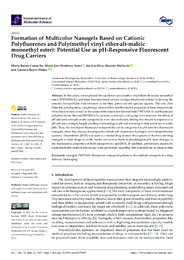Please use this identifier to cite or link to this item:
https://hdl.handle.net/11000/30576Full metadata record
| DC Field | Value | Language |
|---|---|---|
| dc.contributor.author | Rubio-Camacho, Marta | - |
| dc.contributor.author | Martínez Tomé, María José | - |
| dc.contributor.author | MIRA CARRIÓ, AMALIA | - |
| dc.contributor.author | Mallavia, Ricardo | - |
| dc.contributor.author | Reyes Mateo, Carmen | - |
| dc.contributor.other | Departamentos de la UMH::Agroquímica y Medio Ambiente | es_ES |
| dc.date.accessioned | 2024-01-23T12:06:04Z | - |
| dc.date.available | 2024-01-23T12:06:04Z | - |
| dc.date.created | 2021-09-04 | - |
| dc.identifier.citation | International Journal of Molecular Sciences. 2021 | es_ES |
| dc.identifier.issn | 1422-0067 | - |
| dc.identifier.issn | 1661-6596 | - |
| dc.identifier.uri | https://hdl.handle.net/11000/30576 | - |
| dc.description.abstract | In this study, we employed the copolymer poly(methyl vinyl ether-alt-maleic monoethyl ester) (PMVEMA-Es) and three fluorene-based cationic conjugated polyelectrolytes to develop flu orescent nanoparticles with emission in the blue, green and red spectral regions. The size, Zeta Potential, polydispersity, morphology, time-stability and fluorescent properties of these nanoparticles were characterized, as well as the nature of the interaction between both PMVEMA-Es and fluorescent polyelectrolytes. Because PMVEMA-Es contains a carboxylic acid group in its structure, the effects of pH and ionic strength on the nanoparticles were also evaluated, finding that the size is responsive to pH and ionic strength, largely swelling at physiological pH and returning to their initial size at acidic pHs. Thus, the developed fluorescent nanoparticles can be categorized as pH-sensitive fluorescent nanogels, since they possess the properties of both pH-responsive hydrogels and nanoparticulate systems. Doxorubicin (DOX) was used as a model drug to show the capacity of the blue-emitting nanogels to hold drugs in acidic media and release them at physiological pH, from changes in the fluorescence properties of both nanoparticles and DOX. In addition, preliminary studies by super-resolution confocal microscopy were performed, regarding their potential use as image probes. | es_ES |
| dc.format | application/pdf | es_ES |
| dc.format.extent | 23 | es_ES |
| dc.language.iso | eng | es_ES |
| dc.publisher | MDPI | es_ES |
| dc.relation.ispartofseries | 22(17) | es_ES |
| dc.relation.ispartofseries | 9607 | es_ES |
| dc.rights | info:eu-repo/semantics/openAccess | es_ES |
| dc.rights.uri | http://creativecommons.org/licenses/by-nc-nd/4.0/ | * |
| dc.subject | nanogels | es_ES |
| dc.subject | PMVEMA | es_ES |
| dc.subject | fluorescent conjugated polymers | es_ES |
| dc.subject | doxorubicin | es_ES |
| dc.subject | nanoparticles | es_ES |
| dc.subject | drug-delivery | es_ES |
| dc.subject | bioimagi | es_ES |
| dc.subject.other | CDU::5 - Ciencias puras y naturales | es_ES |
| dc.title | Formation of Multicolor Nanogels Based on Cationic Polyfluorenes and Poly(methyl vinyl ether-alt-maleic monoethyl ester): Potential Use as pH-Responsive Fluorescent Drug Carriers | es_ES |
| dc.type | info:eu-repo/semantics/article | es_ES |
| dc.contributor.institute | Institutos de la UMH::Instituto de Investigación, Desarrollo e Innovación en Biotecnología Sanitaria de Elche | es_ES |
| dc.relation.publisherversion | https://doi.org/10.3390/ijms22179607 | es_ES |

View/Open:
ijms-22-09607.pdf
6,96 MB
Adobe PDF
Share:
View/Open:
ijms-1355155-supplementary.pdf
anexo
361,5 kB
Adobe PDF
Share:
.png)
